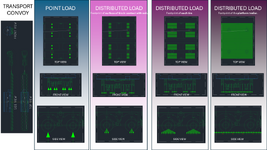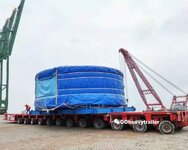TrustButVerify
Mechanical
- Sep 27, 2023
- 48
I have been quite curious about how structural engineers assess bridges when a heavy transport convoy (trailer + cargo) is being driven on top of them.
I have seen different approaches, point loads or distributed loads (with some different criteria as well).
I'm summarizing them in the picture I'm attaching, and I also adding a picture for reference.
The question will be: what is the best approach to follow? or if even several approaches have to be assessed?
Another question could be: will be the same if you are trying to assess some soil like asphalt, or ground?
I have seen different approaches, point loads or distributed loads (with some different criteria as well).
I'm summarizing them in the picture I'm attaching, and I also adding a picture for reference.
The question will be: what is the best approach to follow? or if even several approaches have to be assessed?
Another question could be: will be the same if you are trying to assess some soil like asphalt, or ground?


